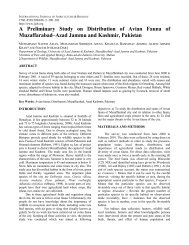Notes on Typhlops diardi - the Wildlife of Pakistan Website
Notes on Typhlops diardi - the Wildlife of Pakistan Website
Notes on Typhlops diardi - the Wildlife of Pakistan Website
You also want an ePaper? Increase the reach of your titles
YUMPU automatically turns print PDFs into web optimized ePapers that Google loves.
6<br />
supralabial (Fig. 1). On body, glands extend from base<br />
<strong>of</strong> <strong>the</strong> scale to its middle.<br />
S<strong>of</strong>t anatomy: The l<strong>on</strong>g, pedunculate rectal caecum,<br />
lies <strong>on</strong> <strong>the</strong> left side <strong>of</strong> <strong>the</strong> rectum, running parallel<br />
to <strong>the</strong> ilium to <strong>the</strong> level <strong>of</strong> posterior end <strong>of</strong> <strong>the</strong> left<br />
kidney, opens at <strong>the</strong> ilio-rectal juncti<strong>on</strong>. The rectal<br />
caecum is l<strong>on</strong>ger than kidney, with black material<br />
inside. The kidneys are el<strong>on</strong>gated fusiform structures,<br />
right l<strong>on</strong>ger and higher in level. <strong>the</strong> ureters run al<strong>on</strong>g<br />
inner side <strong>of</strong> respective kidney, straight to <strong>the</strong> base <strong>of</strong><br />
<strong>the</strong> tail, where ureters join each o<strong>the</strong>r (Fig. 2, A, B).<br />
The testis are el<strong>on</strong>gated, right is much l<strong>on</strong>ger and<br />
is composed <strong>of</strong> four testicular units, it is more<br />
anteriorly placed than <strong>the</strong> left, which is composed <strong>of</strong><br />
three units. Unlike separate testicular units reported<br />
for Leptotyphlops Philip (Warner and Brook, 1967) <strong>the</strong><br />
testis are distended as if in advanced reproductive<br />
state, so <strong>the</strong> testicular units are almost<br />
indistinguishable from each o<strong>the</strong>r (ref. Plate 1, Fig. 1,<br />
Fox, 1965). L<strong>on</strong>g c<strong>on</strong>voluted vas deferentia extend from<br />
<strong>the</strong> anterior end <strong>of</strong> testis to <strong>the</strong> base <strong>of</strong> <strong>the</strong> tail where<br />
both c<strong>on</strong>verge to join each o<strong>the</strong>r and open in <strong>the</strong> comm<strong>on</strong><br />
urinary duct, formed by <strong>the</strong> uni<strong>on</strong> <strong>of</strong> ureters and open in<br />
a pair <strong>of</strong> peculiar urinogenital sacs lying above <strong>the</strong><br />
rectum. The sacs extend to <strong>the</strong> midtail (Fig. 2, A, B).<br />
No sexual dimorphism is reported in this species.<br />
To know sex, all specimen were dissected. The thick<br />
spindle-shaped hemipenial sac extends from cloacal<br />
aperture to <strong>the</strong> base <strong>of</strong> <strong>the</strong> caudal spine. Dissecti<strong>on</strong> <strong>of</strong><br />
<strong>the</strong> sac reveals pitted surface <strong>of</strong> <strong>the</strong> organ with lateral<br />
l<strong>on</strong>gitudinal folds running al<strong>on</strong>g sides c<strong>on</strong>verging at<br />
organ's broad distal tip. The sulcus is deep, median,<br />
runs to <strong>the</strong> top <strong>of</strong> <strong>the</strong> cylindrical organ (Fig. 3, A,<br />
B).<br />
Ovaries are multipartite, right is at a higher<br />
level. The ova are linearly arranged and are at<br />
different stages <strong>of</strong> development. Only right oviduct is<br />
present which opens <strong>on</strong> <strong>the</strong> right side <strong>of</strong> <strong>the</strong> rectum. The<br />
reno-genital regi<strong>on</strong> <strong>of</strong> <strong>the</strong> body is packed with yellowish<br />
U-shaped fatbodies. A median cloacal gland is present in<br />
both sexes (Fig. 3, A, B).<br />
Variati<strong>on</strong>s: Table 1 summarizes morphological data<br />
for <strong>the</strong> present collecti<strong>on</strong>. Most apparent variati<strong>on</strong> is<br />
in <strong>the</strong> total length <strong>of</strong> <strong>the</strong> snakes which varies from 214<br />
to 295 mm, against 430 mm reported in literature<br />
(Boulenger, 1890, 1893; Wall, 1923; Smith, 1943).<br />
Moreover, males are l<strong>on</strong>ger (218-295 Vs 214-215) and<br />
6


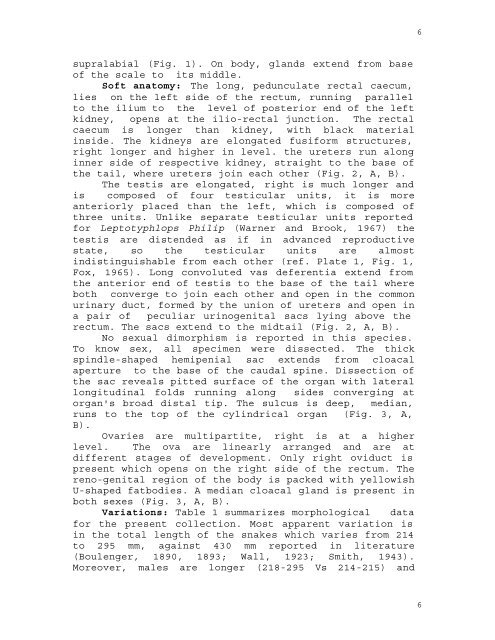

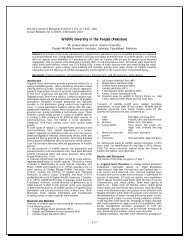
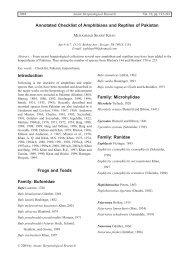



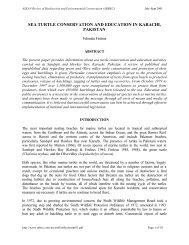
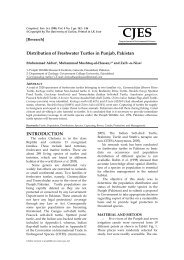
![Dureji (Ovis orientalis [vignei] blanfordi) - Wildlife of Pakistan](https://img.yumpu.com/11814520/1/190x245/dureji-ovis-orientalis-vignei-blanfordi-wildlife-of-pakistan.jpg?quality=85)
